Kitchen Project #14: Choux
Also ft. the GREATEST citrus cream, a continuation of our black sesame adventure and how to adapt your choux
Hello!
Welcome to another edition of Kitchen Projects, a recipe development and cooking journal by me, Nicola Lamb. I’m a pastry chef and recipe developer and bakery consultant.
This week it’s a second dive into the world of black sesame but we’ll also go on a magical choux adventure. AND I’m going to share one of my favourite ever recipes with you - trust me, you’re going to be in love with this cream/curd.
The GIF’s this week have a selection of backgrounds as I moved location part way through writing this. Stage one of the house move is finally complete! All our things are in storage (with varying quality of packing) and I’m currently back at my parents house for the next few weeks before we head to our next place.
It’s lovely to be back here, but I’m definitely getting used to the quirks of the oven. It’s a good reminder, actually, how different appliances can be. A lot of choux got burnt in the making of this edition.
Thank you so much for subscribing, as always. It means the world to me.
Love,
Nicola
PS. Here’s the playlist - lots of songs for you to replace the word ‘who’ with ‘choux’ as you sing along. I personally can’t help myself.
All aboard the choux choux train
Alright alright alright. Are you ready?
For our second dive into black sesame we are also going to branch out into another area of patisserie: The land of choux.
Choux pastry is essentially a perfect vehicle for creams, curds and other delicious things - I don’t think you could design a better edible container: It is tender, yet crisp, and allows you to shovel entire mouthfuls of cream into your mouth in one fell swoop. Ideal.
Whilst it does have a nice flavour, I do consider it to be fairly neutral. Although it physically carries a whole dessert, it really steps back and lets the creams do the talking. What a team player. It’s just so bleedin’ versatile.
So, whilst we’re on the subject: What is your favourite thing to eat in choux / the best choux you’ve ever eaten?
An overview of choux
Let’s talk a bit about what is going on behind the scenes: I like to think of choux as old school because it is steam powered. You start by making an enriched roux by rapidly stirring flour into a simmering mixture of butter, water and milk. Once this has come together and dried out slightly, eggs are beaten in until a ‘dropping consistency’ is reached - it also goes lovely and shiny. This is one of the most confusing parts about choux - the number of eggs is not always consistent.
Depending on how much the pastry has ‘dried out’, the choux pastry might take more or less eggs. This is where you have to use your pastry chef sense and add ‘just enough’. I’ll show you how!
At this point, the choux can be rested overnight, frozen or baked immediately. It’s worth noting the choux can also be baked off and then frozen and then refreshed whenever you need it. After the choux is piped, it is usually topped with a sugary dough called ‘craquelin’, which melts in the oven leaving a crunchy shell around the choux pastry.
When it goes into the oven, the water and milk converts to steam and the choux expands beautifully. The network of proteins from the egg and flour also expand and then set, giving the choux its structure. You are left with a hollow round which is ready to be filled with whatever you so desire. Perfect.
Recipe origins
My choux recipe is adapted from the one I learnt at Dominique Ansel back in New York - it’s super reliable. One of my first roles there was supporting the production team on choux making. Due to the sheer volume of choux pastry the team would make, they had a fabulous machine called a depositor which perfectly piped choux and eclair. Watching this machine work was better than any broadway show.
The Chouxmandments
Choux used to be my nemesis. No matter what I did, it always felt like my choux was destined to be an oily pancake. For years I feared making until one day… it just worked. Looking back on it, I’m pretty sure there were a few errors I would repeat over and over. So, here, I give to you my choux commandments:
Dry it out - Once I’ve added the flour, I like to continue cooking the paste on the heat until it leaves a little dry film on the pan.
The drop - Getting the dropping consistency right is something you will master over time. That being said, I have baked choux that was a bit thick and it worked absolutely fine. Too runny, I’m afraid, is where you get into trouble
Don’t sweat the piping - with the help of craquelin, even the ugliest piped choux will turn out beautiful. With practice, your piping will improve but in the meantime, don’t worry too much. Just try your best - even if they have a funny shape or a pointy tip, you will be popping craquelin on top anyway! You can make your choux neater by using a metal round piping tip - it gives something ‘hard’ for the choux paste to break off against when you flick your wrist during the piping. I hate washing up so I don’t normally bother using a tip for at home choux baking
Bake it HOT - and I mean hot. I pre-heat my oven to 230c and then immediately turn it down to 190c for the first stage of the bake. And please, don’t open the oven!
Bake it ALL THE WAY - After the initial rise, take the temperature way down and let the choux cook all the way through
Don’t look at it - Ok, this is more of a mental tip than an actual tip. Please don’t sit in-front of your oven and watch your choux. It’s worrying. Don’t go back for at least 10 minutes! I’ve spent too much time stressing about the first 5 mins of pancake action in my time to tell you it isn’t worth freaking out about
How to adapt choux
A few months ago I got to thinking about different ways that choux could be adapted. Or, indeed, if it was even worth it. To adapt the choux, I identified two potential areas that flavour could be added: Firstly, the craquelin and then the paste itself.
Let’s break it down:
Adapting the Craquelin (yes that almost rhymes!):
Craquelin is made with an equal amount of butter, sugar and flour. It is usually made with light brown sugar which gives it its signature flavour and look. It is mixed together and then rolled into thin sheets - around 3mm/4mm. Once chilled, small circles are cut and placed on top of the piped choux. In the oven, the craquelin melts as the choux expands leaving a beautifully crunchy crust. It also hides all manner of sins beneath!
In terms of size, the craquelin should be approximately the same diameter as the choux bun underneath. If you don’t have the perfect cutter, a smaller diameter does work but the craquelin is ‘stretched’ over a larger expanse and it doesn’t have the same amount of coating on the bun.I also tested a larger diameter - I was worried it might weigh the choux down but it was absolutely fine. The only real problem it gave me was that certain areas slipped down onto the tray and burned slightly, since there was more craquelin than dough. This was easily solved though - I simply crumbled it off before filling.
Craquelin is definitely an area you can adapt: You may have seen brightly coloured craquelins in the past - you can add food colouring, blitzed up freeze-dried fruits, cocoa powder or anything you like. You will reap the results! A cocoa powder craquelin looks particularly lovely and takes a chocolate cream puff to the next level. Merlin of OSIP recently made a gasp-worthy one. It’s a fun part of the recipe to play around with because you can ‘show’ what is inside the choux by adapting the craquelin to mimic your intended filling - it’s a bit of a preview of things to come.
For the black sesame adventure, I started by adding 25% of the flour weight in sesame seeds at the end. It baked well but didn’t have quite enough sesame in for my liking. I upped it to 40% and it was perfect! The sesame seeds got real nutty in the oven and added another textural element.
Adapting the paste:
Whilst choux usually comes alive by its fillings, I wondered whether I could add the black sesame to the choux paste itself and, as a result, achieve a dramatic looking black cream puff.
I started by making my regular choux paste mixture and - after all the eggs were in - added around 10% of the weight in black sesame paste. Why 10%? Knowng how choux operates, I didn’t want to add too much in that would ‘weigh down’ the paste or get in the way of a good rise.
I piped the choux and put them in the oven as usual. Was it just me, or were these not rising as much? Although they puffed - and looked absolutely gorgeous in monochrome - I was a bit miffed. They definitely seemed a bit diminutive next to the originals. Taste wise, they were lovely. Just a hint of black sesame but the colour? Just magical. The innards were so tender, too.
To check that I wasn’t losing my mind, I piped 20g of regular choux next to 20g of the black sesame choux and baked. The result?
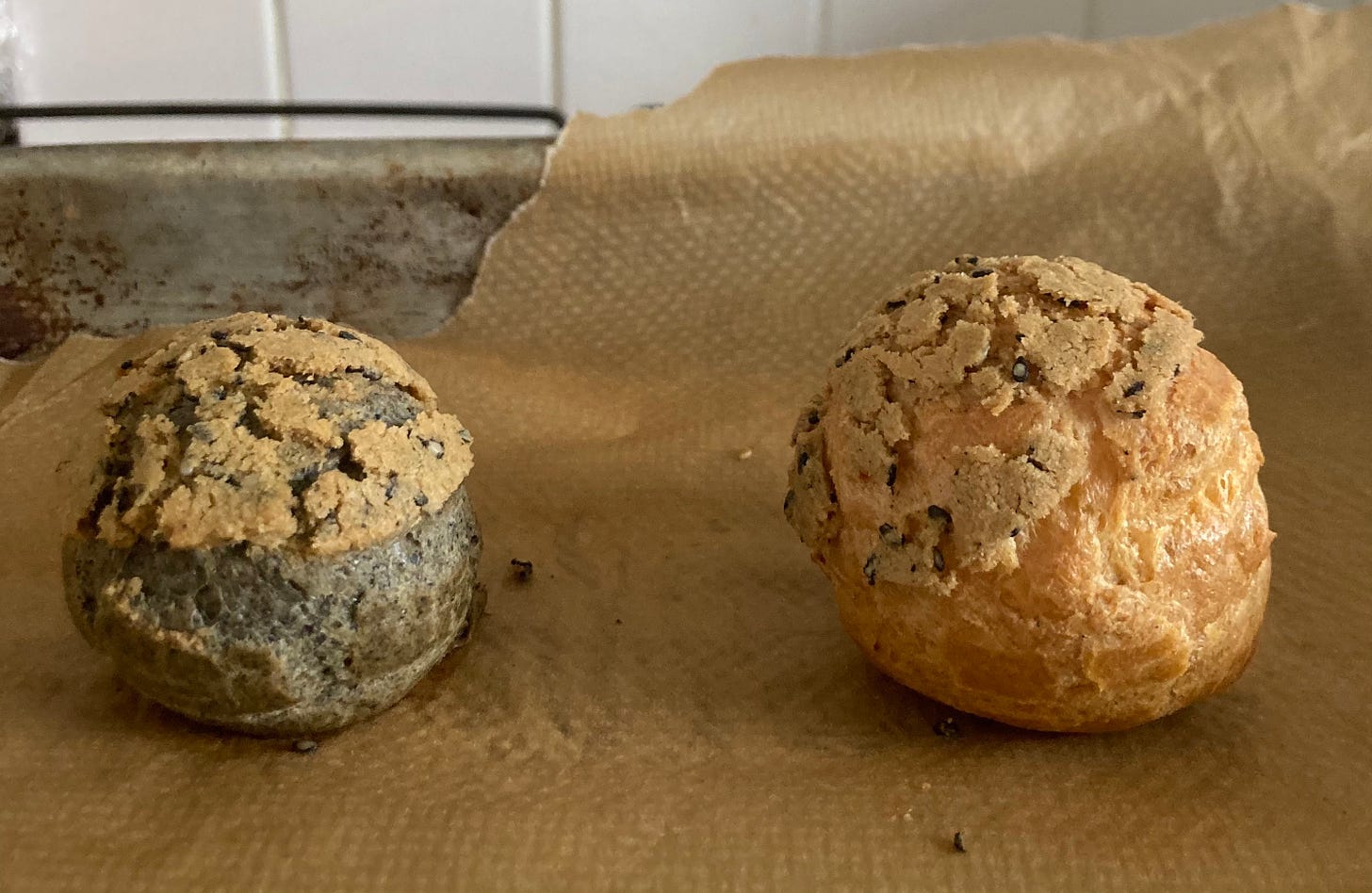
The black sesame was definitely smaller. As predicted, the black sesame inhibits the rise of the choux pastry. You can see a visual of this below - the black sesame version is about 75% of the size of the regular version. Although this may not seem like a lot, it is worth factoring in to your desserts if you decide to go with this version! Although there may be a scientific workaround, my advice? Pipe your buns slightly larger.
What’s your choux size?
In a professional setting, it’s normal to use a piping tip when you pipe your choux. This helps regulate the size of the choux but also gives you a hard edge to ‘whip’ the tip around and cut the flow of the paste, helping you get a neat mound. At home, I never bother with a piping tip.
I simply fill my pastry bag and cut a 1cm - 1.5cm hole. I pipe rounds of about 3cm - having scaled these, they weigh approx 15g each. This doesn’t sound like much but they do puff up dramatically and end up a very good size.y
Filling those choux
When you fill a choux bun you’ve got lots of choices - you can fill from the bottom through small hole (usually employing a nice thin piping tip with a stabby end) or you can slice the very top off the choux buns and fill from the top, making the ‘hat’ part of your final decoration. Alternatively, you can cut the choux in half and fill it with ice cream, a dollop of cream or anything you like. I highly recommend ice cream. ESPECIALLY if you use the ice cream from last week’s kitchen projects. It is an experience you need to have at least once.
Side note: If you’re ever in HK, please stop by Owl’s in TST. It was here that I had my first ever choux bun/ice cream combo and I think about it often.
Alright, shall we do this?
A bit about this week…
This week, I’m giving you a few options. First, I’ve adapted my good old pastry cream recipe to real black sesame magic. To get it to the right consistency, I increased the starch a bit to make up for the liquid black sesame paste - it is so unctuous and creamy.
Secondly, I’m going to share one of my absolute favourite ever citrus cream recipes with you - I recommend making it with yuzu, if you’ve got it, but if you don’t then lemon will be fine too. Trust me, this cream is OUTRAGEOUS - it is silky, thick and so loveable. The sharp but luscious citrus cream works perfectly with the earthy black sesame custard. Total pastry nirvana. This cream is a variation on a recipe created by Pierre Herme and popularised by the brilliant Dorie Greenspan. It’s similar to the perfect lemon cream tart served at tartine, too!
To complete, I recommend also making some of the black sesame fudge sauce from last week’s Kitchen Projects and - if you wanna get real fancy - you can make a little chantilly whipped cream to finish it off.
The recipes
Today’s Kitchen Project will be a bit of a choose your own adventure. I will share both choux recipes with you - it’s up to you which you’d like to make. You can always make a large batch and then split it in half and then you can try both!
Special equipment:
Piping bags
Optional: Piping nozzle - star nozzle for the chantilly cream. I don’t have wilton brand so I can just tell you that the nozzles is about 1.25cm wide
Choux pastry - black sesame optional
This makes around 15-20 choux buns
55g butter
55g water
55g milk
1g salt
2g sugar
55g flour
85g-100g egg (approx 1.5 - 2)
25g black sesame paste, if desired
Black sesame craquelin
50g soft butter
50g plain flour
50g light brown sugar
20g black sesame seeds
Suggested fillings:
Black sesame pastry cream - makes 300g
165g milk
50g caster sugar
30g egg yolks
15g cornflour
40g black sesame paste
Yuzu cream - makes 300g
30g yuzu juice
20g lemon juice (you can use all yuzu but it is expensive and I like the extra kick you get from lemon!)
1 egg
1 egg yolk
70g sugar
1g salt
100g butter
Creme chantilly
200g double cream
25g caster sugar
+ Sesame snaps or home-made sesame brittle
+ Pure black sesame paste OR black sesame fudge sauce - from last week
Choux method - I have used a mixture of GIFs from the black sesame and the plain choux! The method is exactly the same
Heat together butter, milk, water, salt and sugar until the liquid is simmering and butter has melted. If you are using black sesame paste, add it to the choux paste now
Turn the heat down and pour in sifted flour. Stir rapidly until a paste forms
Continue cooking on a low heat to dry out the paste - it will take a minute or two - and there is a dry film on the pan
Move paste into a clean bowl and allow to cool slightly
Beat in the egg, little by little. At first it will split apart but it will come back together
Continue adding egg until the choux paste reaches ‘dropping consistency’ and is very shiny. Here is the paste just before dropping consistency:
At this point you can store the choux in the fridge, freezer or pipe and bake it immediately
To pipe the choux: Pipe mounds around 3cm wide and 2.5cm tall. If you want to scale it, I think around 15-20g makes a decent sized bun
Top with craquelin - cut to a similar size - before baking (recipe below)
To bake the choux, pre-heat the oven to 220c fan. This ensures the oven is very hot. Turn the oven down to 190c fan when you put the choux in. After 15 mins, turn the oven down to 160c fan. Depending on the size of your choux buns, bake for additional 10 - 15 mins
**Please note, all ovens are different and particular. If you know yours is a burn factory then please reduce the oven temps by a little bit - 5 or 10c is sufficient. Also, do not open the oven before the first 15 mins is up!**
Craquelin method
Mix together (not cream - you don’t need any air in this) soft butter and brown sugar. Then stir in the flour and sesame seeds
Roll out to 3-4mm thickness between two sheets of paper and chill until needed
When ready to use, cut circles approx the same size as the piped choux. It’s best to warm the craquelin up slightly with your hands before cutting otherwise it will crumble
Craquelin can be rerolled over and over again!
Black sesame custard method
Heat milk until simmering
Meanwhile, whisk egg yolks with cornflour, sugar and black sesame paste
Temper the egg yolks with by pouring a little hot milk on the mixture and whisking well - then return the whole mixture to the stove
Heat on medium until thickened
Leave to cool completely
As the cornflour has a jellifying effect, you must beat the creme pat with a spatula before using it to make it smooth and lush
Yuzu/Citrus cream method
Whisk together eggs, lemon juice, yuzu juice and sugar
Heat over a bain marie until the mixture is extremely thick - the foam will disappear and it will become extremely lush. If you want to temp it, I take it to around 80c but you don’t need to. Just whisk it until very clear trails are left in the curd
Take off the heat and allow to cool for around 10 minutes
Begin whisking in the butter, bit by bit
Once it is all in, leave to cool completely
Chantilly cream
Whisk cream and sugar until slightly thickened. To you, it may look underwhipped but i assure you it is not. You want it to look like creme fraiche. That is all. DO NOT go past it looking ‘just’ thick enough as it will continue to thicken as you pipe it
For a good lookin choux, I recommend 1.5cm wide tip - if you use a small tip, the chantilly will likely overwhip as it passes through
Putting it all together
For your own tailored choux experience, feel free to mix around the fillings. But here’s a few options for you:
Version 1
Cut JUST the tip of the choux bun off. Set aside.
First pipe in your citrus cream
Next goes in a little bit of pure black sesame paste or the fudge sauce
Top with a little black sesame custard
Pipe a swirl of chantilly cream
Pop the hat back on
If desired, decorate further with sesame brittle
Version 2 - no chantilly cream, piped from the base
Turn the choux upside and make a small hole in the base
First pipe in the black sesame paste/fudge sauce
Next the lemon cream
Finish with the pastry cream
If desired, use a little chantilly, curd or custard to pipe a blob on top and finish with a little sesame brittle

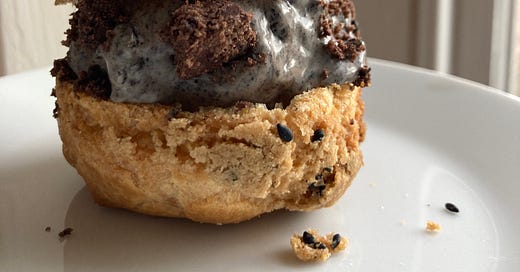


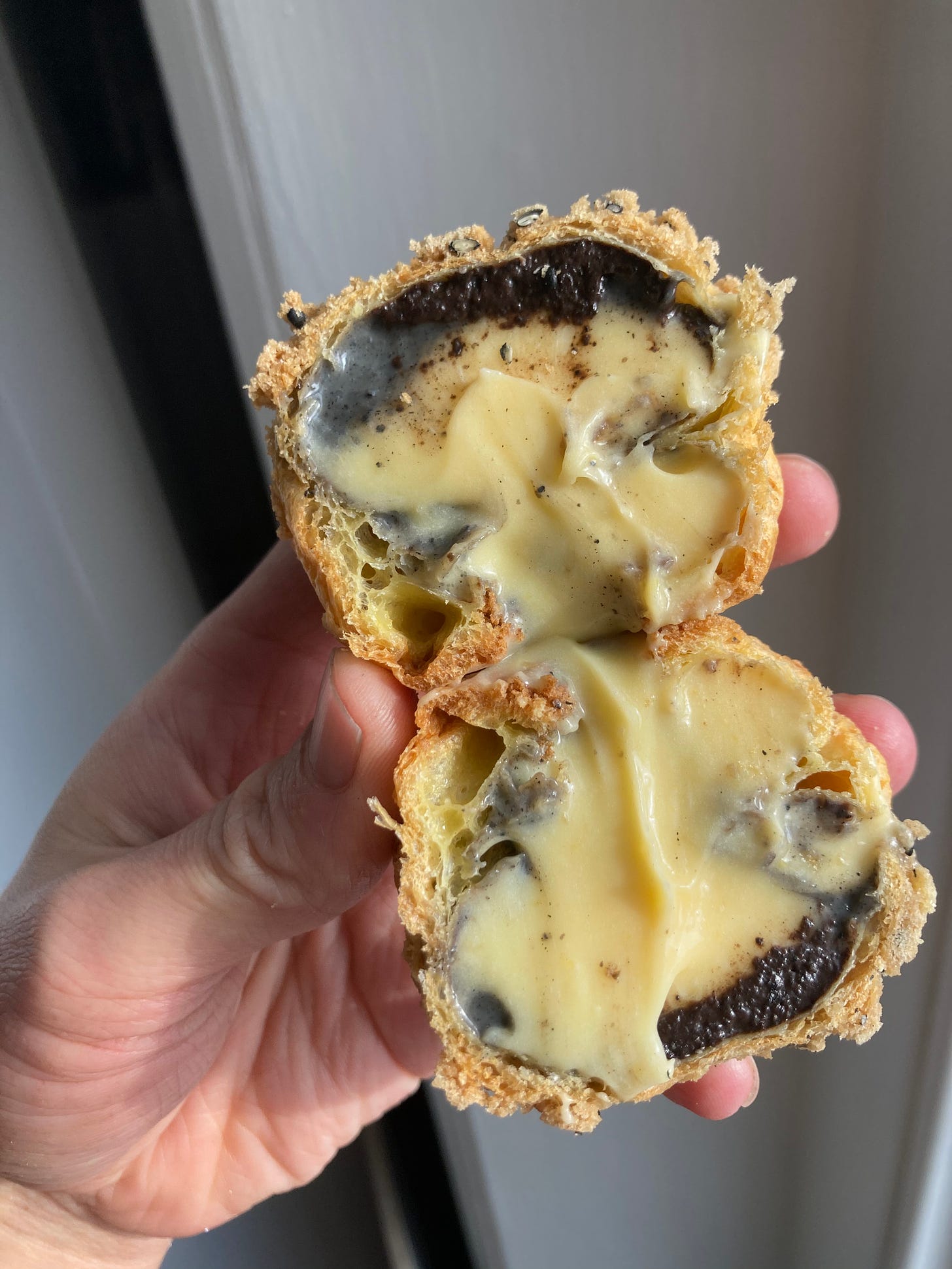
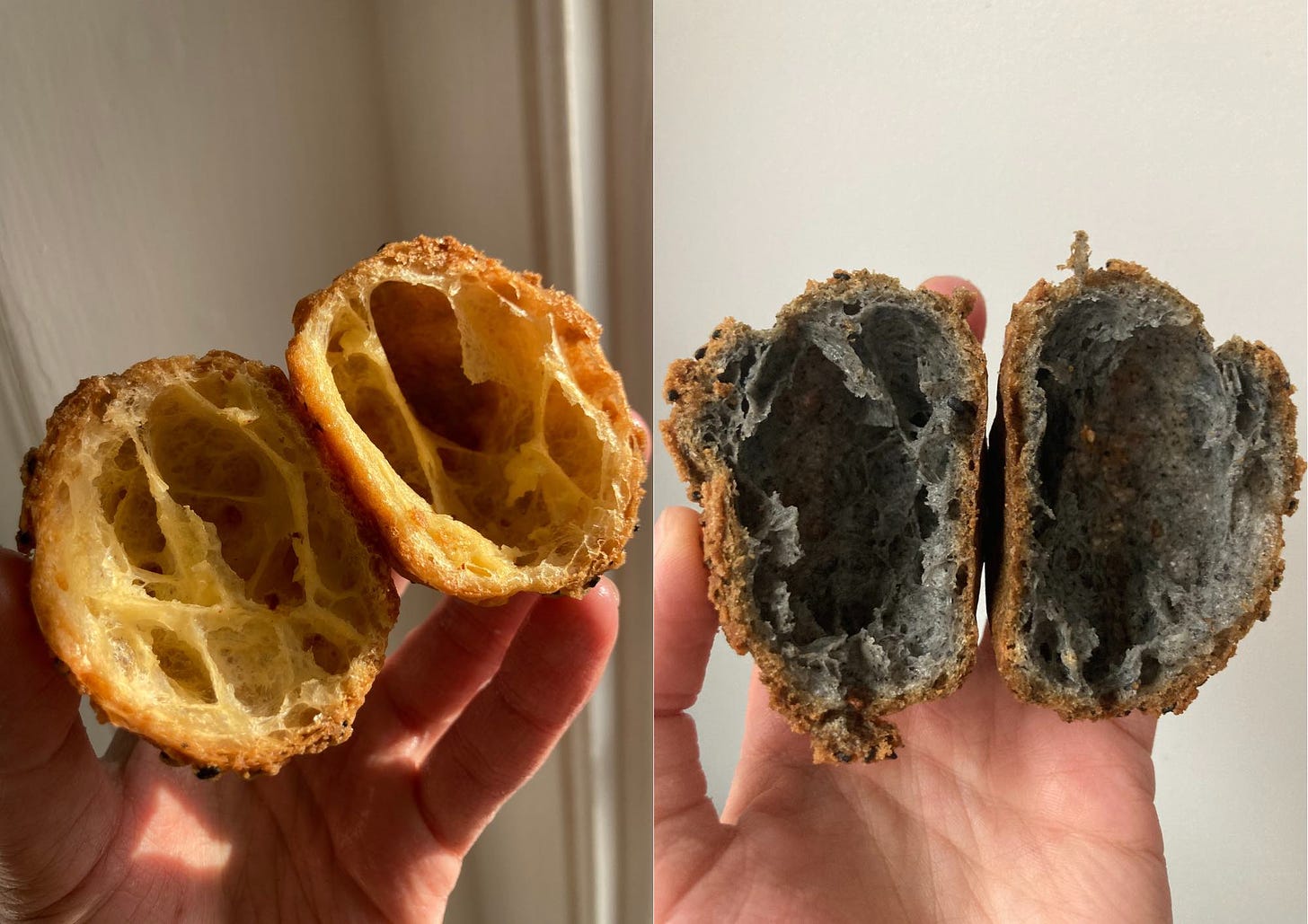
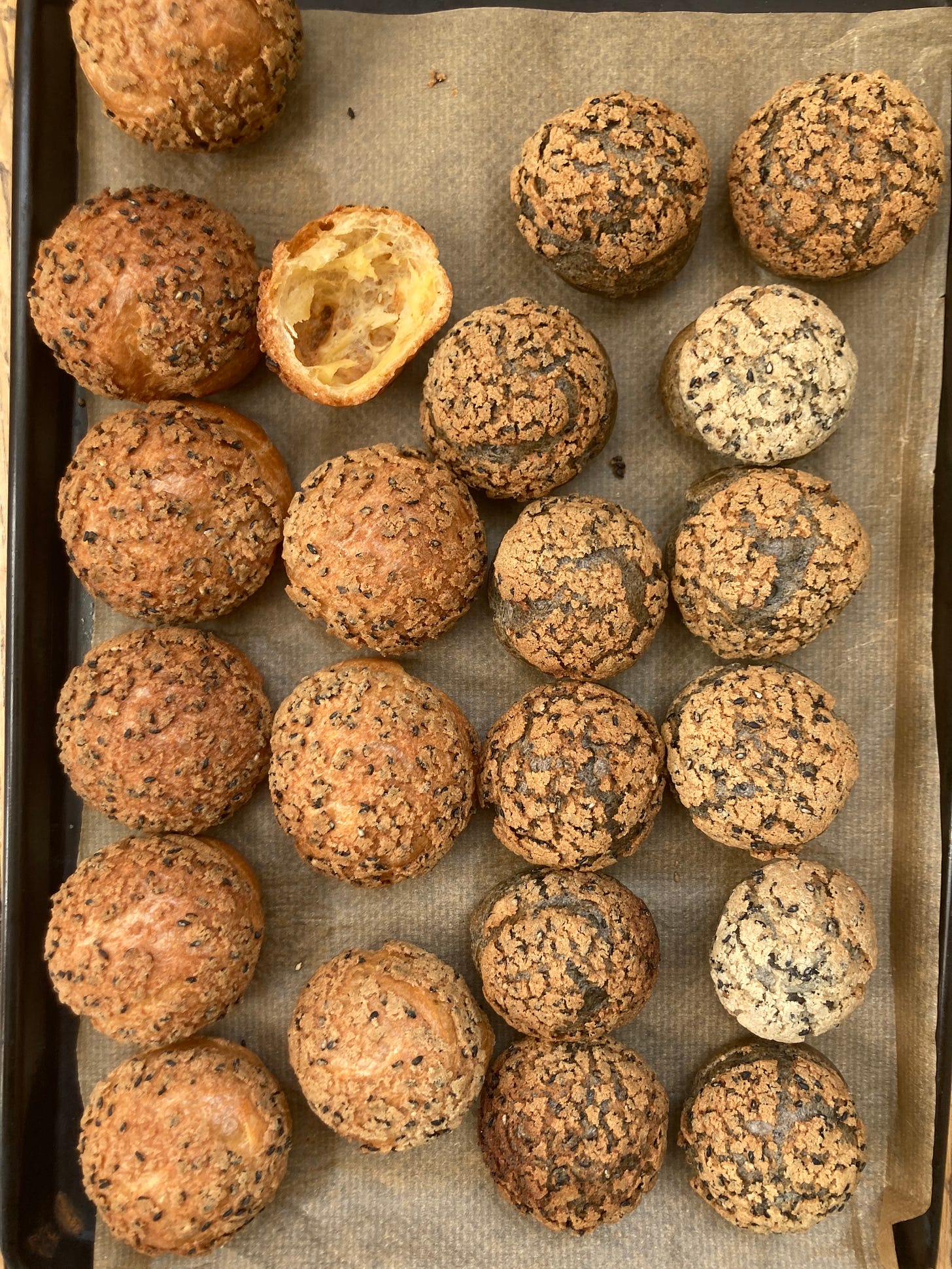

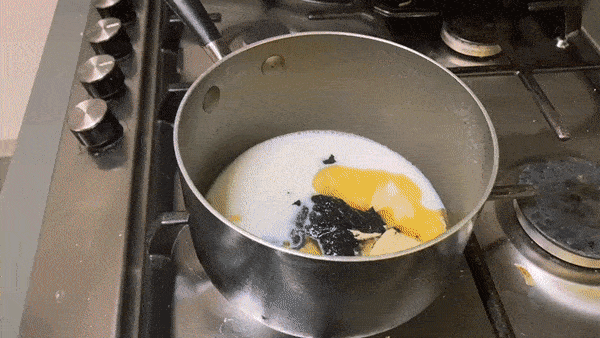
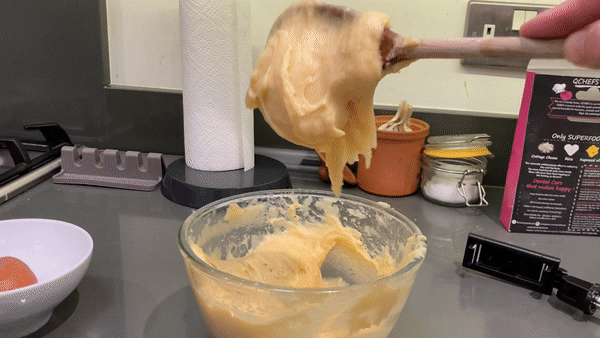
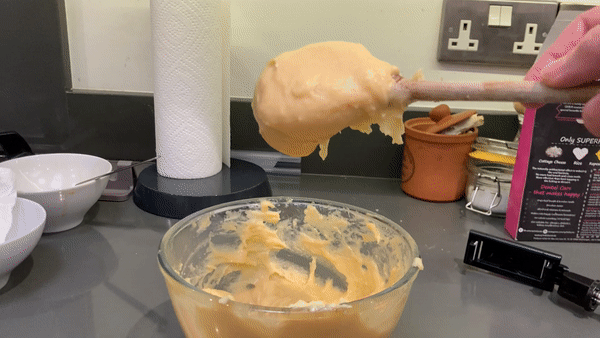

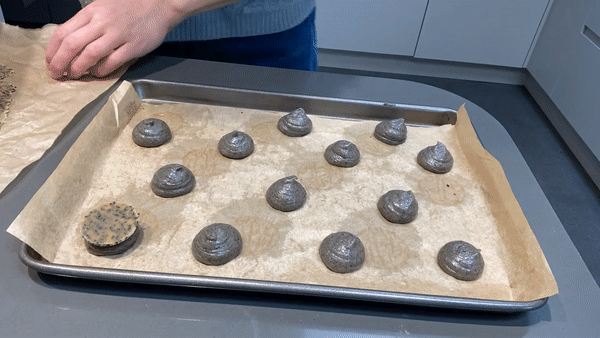
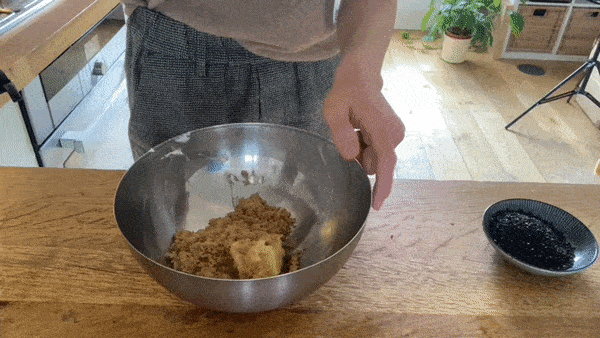
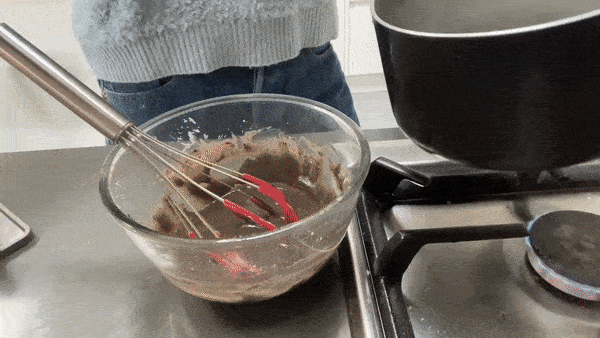
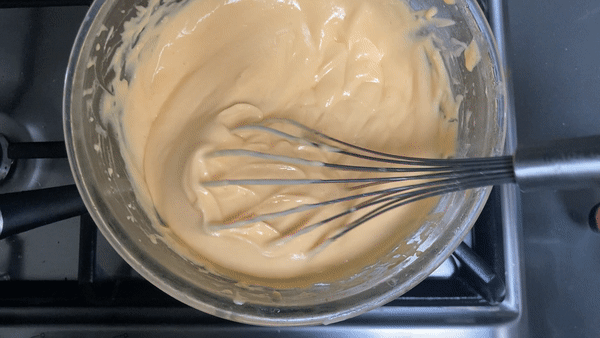
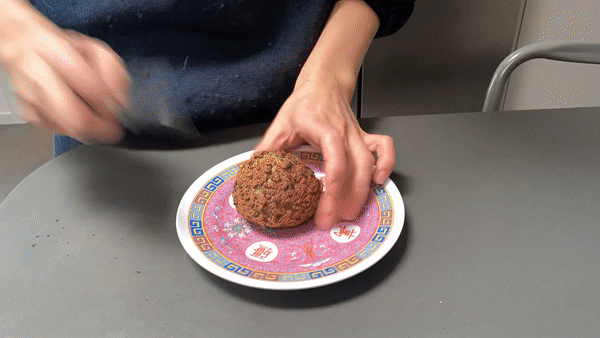
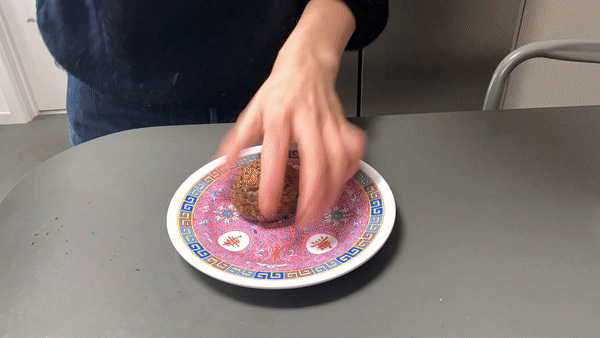
So so excited to try this when I have a bit more time! I used to work at Maitre Choux in South Kensington as a barista and shop assistant and we were allowed to take unsold produce home at the end of the day. God I loved that job. They were all amazing but Paris Brest eclair was just so ridiculously lush. Perfection.
I had my tiny mind exploded by choux at Maison du Choux in Paris. I even bought a tote bag.